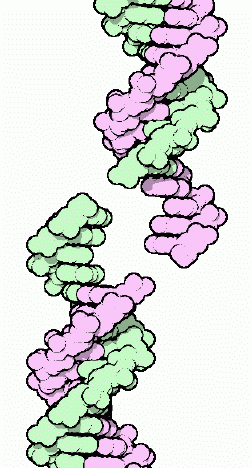|
Inhaltsübersicht | Nanomaschinen | Moleküle | Programme | Kurse | Fun | Links |
||
| > |
Restriction Enzymes
Sticky Ends
The booming field of biotechnology was made possible by the discovery of restriction enzymes in the early 1950's. With them, DNA may be cut in precise locations. A second enzyme--DNA ligase--may then be used to reassemble the pieces in any desired order. Together, these two enzymes allow researchers to assemble customized genomes. For instance, researchers can create designer bacteria that make insulin or growth hormone or add genes for disease resistance to agricultural plants.
An interesting property of restriction enzymes simplifies this molecular cutting and pasting. Restriction enzymes typically recognize a symmetrical sequence of DNA, such as the site of EcoRI:

Notice that the top strand is the same as the bottom strand, read backwards. When the enzyme cuts the strand between G and A, it leaves overhanging chains:

These are termed "sticky ends" because the base pairs formed between the two overhanging portions will glue the two pieces together, even though the backbone is cut. Sticky ends are an essential part of genetic engineering, allowing researchers to cut out little pieces of DNA and place them in specific places, where the sticky ends match.
Previous: Restriction Enzymes
Next: Explore the Structure
Last changed by: A.Honegger,
